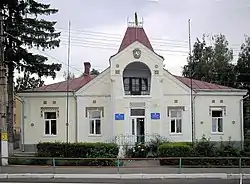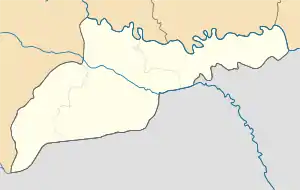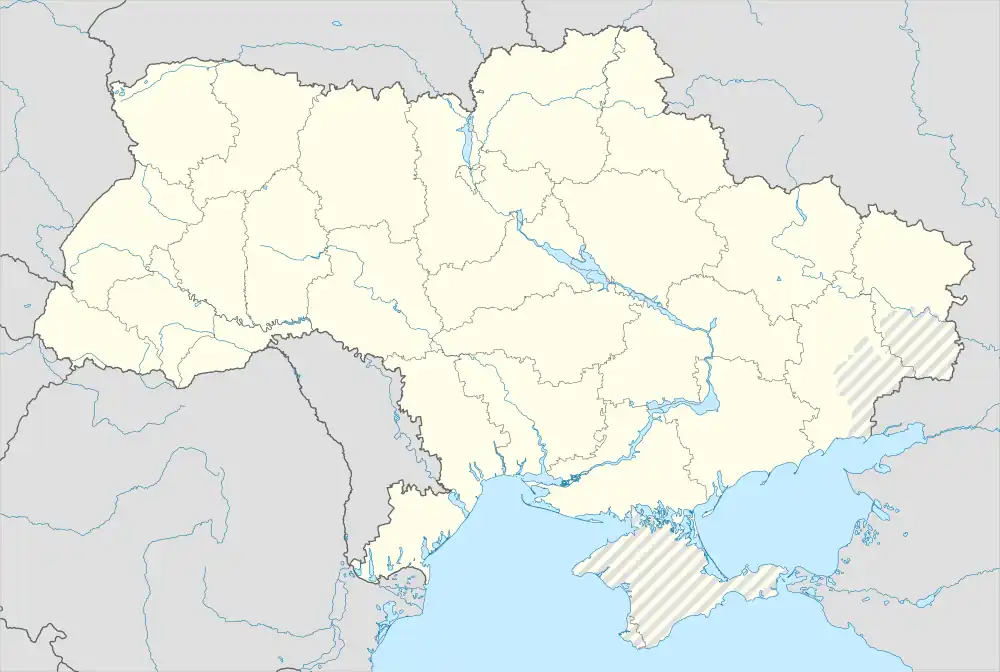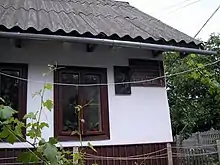Kitsman
Кіцмань Coțmani • קאצמאן | |
|---|---|
 Kitsman City Hall | |
 Flag  Coat of arms | |
 Kitsman Location of Kitsman  Kitsman Kitsman (Ukraine) | |
| Coordinates: 48°26.5′N 25°45.6′E / 48.4417°N 25.7600°E | |
| Country | |
| Oblast | |
| Raion | Chernivtsi Raion |
| First chronicled | 1413 |
| City rights | 1798 |
| Government | |
| • City Head | Serhij Buleha |
| Elevation | 232 m (761 ft) |
| Population (2022) | |
| • Total | 6,049 |
| Time zone | UTC+2 (EET) |
| • Summer (DST) | UTC+3 (EEST) |
| Postal code | 59300-06 |

Kitsman (Ukrainian: Кіцмань, romanized: Kicmań, IPA: [ˈkitsmɐnʲ]; Romanian: Coțmani, older Cozmeni or Chițmani; Yiddish: קאצמאן, romanized: Kotzman) is a city located in Chernivtsi Raion, Chernivtsi Oblast, in the historical region of Bukovina of western Ukraine. It hosts the administration of Kitsman urban hromada, one of the hromadas of Ukraine.[1] The town is about 20 km (12 mi) northwest from Chernivtsi on the road to Zalishchyky. Population: 6,049 (2022 estimate).[2]
Name
The original name - Cozmeni - is derived from the Romanian/Moldavian surname ”Cozma” and had the meaning of "Cozma's kin settlement". Forming a village name from an existing name by adding the "-eni" suffix is widely spread in the Romanian speaking area. After the Habsburg annexation it was easier for the German speaking administration to use the "-mann" ending.
According other interpretations, the old surname Kitzman/Kotzman (and variations thereof) originated in Jewish culture, which had gradually become more common in parts of western Ukraine. The name was occupational and derivative of Hebrew roots; shortening the phrase kohen Tsedek ("priest of righteousness").
History
Moldavia 1413–1775
Habsburg monarchy 1775–1804
Austrian Empire 1804–1918
Kingdom of Romania 1918–1940
Soviet Union (Ukrainian SSR) 1940–1941
Kingdom of Romania 1941–1944
Soviet Union (Ukrainian SSR) 1944–1991
Ukraine 1991–present
The first historical mention of Kitsman is dated to 1413, which also appears on the city's crest. Kuzmyn Forest (Codrii Cozminului), woods are situated between Siret and Prut valleys next to the town are named so, because they are traversed by the roads that connect Suceava, the Middle Ages' capital of the Principality of Moldavia, with what was then its boundary town of Cozmin / Kozmyn (modern village Valia Kuzmyna in Chernivtsi Raion).
Just before the Habsburg annexation of this part of the Principality of Moldavia, both Romanian principalities (Moldavia and Wallachia) (at the time, Ottoman vassals) were invaded by Czarist Russia's army as a stage of a Russo-Turkish war. During the Russian occupation, Field-Marshal Count Pyotr Alexandrovich Rumyantsev ordered a census in these two principalities. According this census, the population in Cozmeni/Kitsman in 1774 comprised 105 Romanian families, one Jewish, and 15 "Russian". The term "Russians" covered Ruthenians/Ukrainians, Muscovite Russians, and Lipovans all together in the quoted census).[3]
In the Austrian period (1774–1918), Kitsman (known as Kotzman/Kotzmann in German), as part of the Duchy of Bukovina, was the seat of the planning section of the district administration and it had a district court and a public school opened under the name of "Moldavische Trivialschule" (German for "Moldavian Elementary School"), where instruction was given in the Romanian language initially (1780s), then in German language (mid 19th century) and then Ruthenian (Ukrainian) language. From an ethnic perspective, the Austrian Empire supported Ruthenization – to keep the native Moldavians away from Moldavia (1774–1859) and away from Romania (after the Unification of Moldavia and Wallachia in 1859 to form modern Romania); while from an religious perspective, the Austrians promoted the Greek Catholic Church, to keep the population away from the other neighbor – Orthodox Russia.
The farmers from the 13 surrounding villages brought their produce to the market in Kitsman.
In November 1918, right after World War I, the union of Bukovina with Romania was declared. During the period of Romanian rule (1918–1944), the Romanian authorities viewed the Ukrainians (Ruthenes) as Ruthenized Romanians and attempted to reverse such a process by prioritizing schooling in Romanian.
After the Molotov–Ribbentrop Pact of August 1939, the Soviet Union occupied Bessarabia and Northern Bukovina (including the Hertsa region) in June 1940. In June 1941, Romania entered World War II on the side of the Axis and re-established control over the region. The 1940 process was wrongly associated with the Jewish population; thus, Jews were seen by some as enemies of the state whose suppression was one of the goals of the state, while others, such as the mayor of Cernăuți, Traian Popovici, worked hard to save the Jews from deportation.[4]
A local newspaper has been published here since June 1, 1941.[5]
In January 1989 the population was 9,500 people,[6][7] while in January 2013 the population was 6,762 people.[8]
Until 18 July 2020, Kitsman served as an administrative center of Kitsman Raion. The raion was abolished in July 2020 as part of the administrative reform of Ukraine, which reduced the number of raions of Chernivtsi Oblast to three. The area of Kitsman Raion was split between Chernivtsi Raion and Vyzhnytsia Raion, with Kitsman being transferred to Chernivtsi Raion.[9][10]
Jewish community
Out of the population of 6,000 that Kitsman had, approximately 700 (11.6%) were Jews who had emigrated from nearby areas of Galicia at the beginning of the 19th century and who dealt mainly with commerce in agricultural products. They also were occupied as craftsmen and were practically the only representatives of the intellectual professions. There were Jews in the ranks of the judges and in the bureaucracy. To name a few, Nathan Seidmann, a clerk in the planning section of the district administration in Kitsman who in his time as a member of the executive committee 2 during the years 1921 to 1927 and intermittently as chairman of the Zionist organization, performed notable service. Before 1914, the Jews and the Ruthenian (Ukrainian) population of the town and the surrounding villages co-existed in peace.
Notable people

- Volodymyr Ivasyuk (1949–1979), Ukrainian songwriter, composer, and poet
- Ani Lorak (born 1978), Ukrainian singer, songwriter, actress, and entrepreneur
- Ioan Țurcan (1818–1902), ethnic Romanian Orthodox priest and politician in Austria-Hungary, in the Duchy of Bukovina
- Iancu Zotta (1840–1896), ethnic Romanian politician in Bukovina, within Austria-Hungary
References
- ↑ "Кицманская громада" (in Russian). Портал об'єднаних громад України.
- ↑ Чисельність наявного населення України на 1 січня 2022 [Number of Present Population of Ukraine, as of January 1, 2022] (PDF) (in Ukrainian and English). Kyiv: State Statistics Service of Ukraine. Archived (PDF) from the original on 4 July 2022.
- ↑ Дмитриев, П. Г. (1973). "Народонаселение Молдавии (по материалам переписей 1772-1773, 1774 и 1803 гг.)" (in Russian). Штиинца (Știința), Кишинев (Chișinău).
- ↑ ""Lista lui Schindler" din Bucovina. Poveste fabuloasă a lui Traian Popovici, primarul-erou care a salvat 20.000 de evrei". Libertatea Cuvântului (in Romanian). August 13, 2023. Retrieved July 26, 2022.
- ↑ № 3270. Советская жизнь // Летопись периодических и продолжающихся изданий СССР 1986 - 1990. Часть 2. Газеты. М., «Книжная палата», 1994. стр.427
- ↑ Всесоюзная перепись населения 1989 г. Численность городского населения союзных республик, их территориальных единиц, городских поселений и городских районов по полу
- ↑ Кицмань // Большой энциклопедический словарь (в 2-х тт.). / редколл., гл. ред. А. М. Прохоров. том 1. М., "Советская энциклопедия", 1991. стр.585
- ↑ "Чисельність наявного населення України на 1 січня 2013 року. Державна служба статистики України. Київ, 2013. стор.108" (PDF). Archived from the original (PDF) on 2013-10-12. Retrieved 2019-08-03.
- ↑ "Про утворення та ліквідацію районів. Постанова Верховної Ради України № 807-ІХ". Голос України (in Ukrainian). 2020-07-18. Retrieved 2020-10-03.
- ↑ "Нові райони: карти + склад" (in Ukrainian). Міністерство розвитку громад та територій України. 17 July 2020.